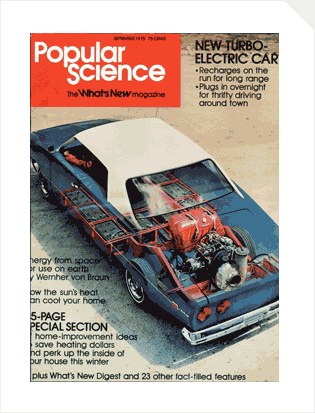The Persistent Contender: PopSci Covers the Hybrids
Popular Science took its first extensive look at a gasoline-electric automobile in 1916.

by Popular Science, September 1975
Plugs in overnight for thrifty driving around town.
Hybrid gasoline-electric vehicles began appearing late in the 19th century
from manufacturers such as the Compagnie Parisienne des Voitures Electriques
in France. In this country, an engineer named H. Piper applied for a patent
on a gasoline-electric motor combination on Nov. 23, 1905. By the time Piper
received his patent three years later, however, advances in gasoline engines
had begun to eclipse the performance of his and other hybrids. Among other
obstacles, electricity was costly in comparison with gas, which was also more readily available. By 1920, hybrid technology had all but disappeared.
Popular Science took its first extensive look at a gasoline-electric
automobile in 1916. We showcased a hybrid car built by an unnamed “western
manufacturer,” which had two levers on the steering column, one for the gas
engine and the other for the electric motor. The motor brought the car to 20
mph, when the gas engine kicked in for cruising. A “slight (twist) of the
electric lever” recharged the battery.
A half-century later, the oil crisis of the 1970s resurrected interest in
hybrids, and several experimental vehicles were developed. Popular Science´s
September 1975 cover story featured a turbine-electric car from electronics
engineer Harry Grepke. Grepke´s TurElec included eight Sears 12-volt truck
batteries and a Solar Aircraft 400-cycle turbine generator; it weighed 3,500
pounds and didn´t leave much room for passengers. This time around, we were
ready for a hands-on, joining the inventor for a highway ride on a prototype, amidst startled motorists near Bradenton, Florida. We expected little more than a glorified golf cart, and were way wrong.